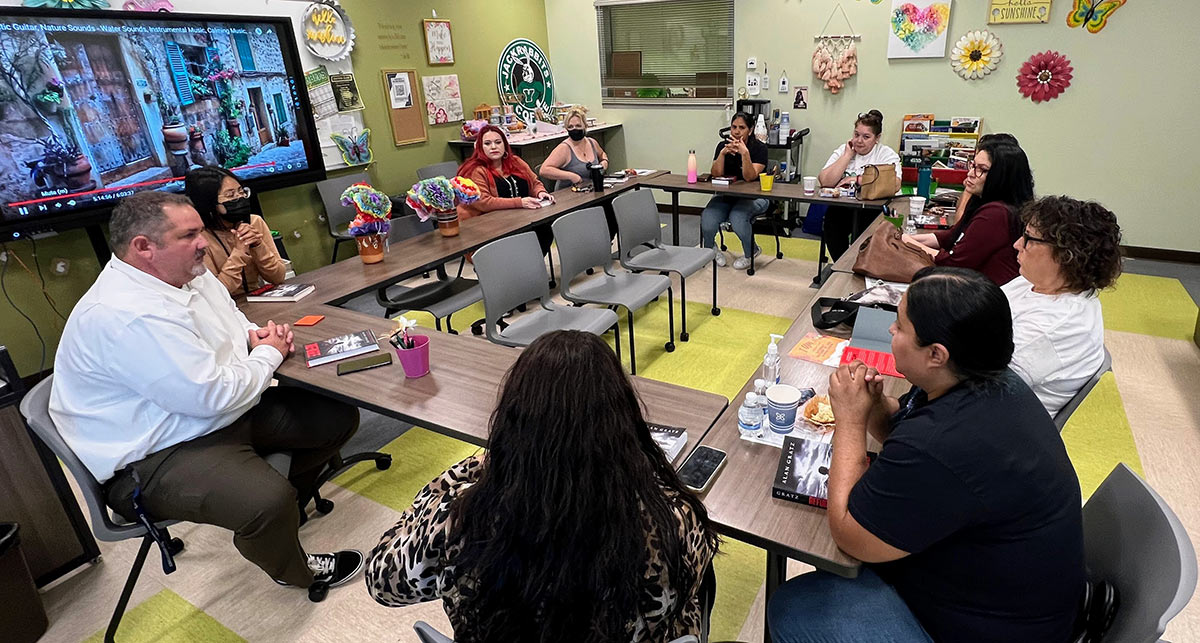class act Best practices in action
Best practices in action

class act
Best practices in action

Victor Valley Union High School District team supports parents and students

Increasing enrollment, attendance and graduation rates, and a falling dropout rate are some of the positive changes that Victor Valley Union High School District credits in part to its Family Engagement Program.
“The parent or guardian is a child’s first teacher, so you have to make an effort to reach out to them in multiple ways,” said Kris Reilly, the San Bernardino County district’s public engagement information manager.
The Golden Bell Award-winning program, which kicked off in 2016, is a data-driven approach to improving student outcomes. Research shows “that family engagement in schools contributes to improved student achievement, decreased disciplinary issues, improved parent–teacher and teacher–student relationships, and improves school environments,” according to Reilly.
Seven of Victor Valley Union HSD’s eight schools have family engagement liaison positions, which are led by a district-level director of Student Services. The positions are sustainably funded through the district’s general fund. The team’s duties have included making home visits and connecting families to local resources, coordinating with educational programs like the Parent Institute for Quality Education and Parent Institute for Bilingual Education to offer opportunities to parents, and offering adult education resources to parents. The liaisons also facilitate events like Coffee with the Principal; perform outreach via social media, email and other digital communication tools; and assist with the district’s technology program, which provides free computers to families following the completion of a training course.
The community consists of a large population of Spanish speakers, Reilly noted, and most of the liaisons are bilingual. Translation services are offered for various meetings.
Being aware of the local landscape and attempting to reach parents through multiple mediums (in-person and virtual events, social media, community centers, etc.) are some ways to help bolster engagement.
“Just know your community and know your demographic and the kinds of things that they might need. If you’re dealing with a high percentage of economically disadvantaged students, then you know you want to make your parents aware of certain programs that might help them. If you have a highly bilingual community then … you want to be able to offer things in Spanish and English or whatever other language it may be,” Reilly explained.
Having the support of the school board, as is the case in Victor Valley Union HSD, is also helpful. “It’s important because the more we can involve our families and our parents, the better connection we have as a team working together to help their students succeed,” said Board President Penny Edmiston.
Enrollment in the district has grown since the program first started — from less than 9,000 students in 2016 to more than 11,000 in 2022.
“Enrollment grows based on a number of factors, but our increase in enrollment outstrips some of the other districts neighboring us, so I think that’s just a result of a positive relationship with the community and a better perception of our district,” Reilly said.
Additionally, average daily attendance rose from 9,398 in 2016–17 to 10,214 in 2020–21 and the district’s graduation rate grew from 67.1 percent in 2016–17 to 78.4 percent in 2020–21. During that same period, the dropout rate decreased from 18.9 percent to 13 percent.
“There are a number of factors there, but the introduction of the Family Engagement Program coincides with that timespan,” Reilly said of the improvements.
Efforts around family engagement are especially critical now as schools attempt to make up for lost learning time and address social-emotional needs and other issues brought on by the pandemic.
In 2020, the program team became part of the state’s Community Engagement Initiative (CEI). They regularly meet with other local educational agencies that are part of the initiative to share best practices and further CEI goals like finding effective models and metrics to evaluate strategies, building capacity to facilitate hard conversations around improving student outcomes, and ultimately sharing information with other LEAs to expand engagement efforts statewide.
The program is also in line with community school practices. Edmiston noted that it lays a good foundation to apply for related grants from the state.
“If we’re able to obtain that grant, we could expand a program that started humbly,” Edmiston said. “We know students don’t learn if basic needs aren’t met; we need to meet those needs. The family liaisons help with all kinds of issues that a family might have and make that bridge between the school, the parent and the child.”
— Heather Kemp